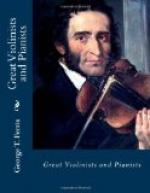Perhaps no better characterization of Liszt could be made than to call him the musical Victor Hugo of his age. In both these great men we find the same restless and burning imagination, a quickness of sensibility easily aroused to vehemence, a continual reaching forward toward the new and untried and impatience of the old, the same great versatility, the same unequaled command of all the resources of their respective crafts, and, until within the last twenty years, the same ceaseless fecundity. Of Liszt as a player it is not necessary to speak further. Suffice it that he is acknowledged to have been, while pursuing the path of the virtuoso, not only great, but the greatest in the records of art, with the possible exception of Paganini. To the possession of a technique which united all the best qualities of other players, carrying each a step further, he added a powerful and passionate imagination which illuminated the work before him. Wagner wrote of him: “He who has had frequent opportunities, particularly in a friendly circle, of hearing Liszt play, for instance, Beethoven, must have understood that this was not mere reproduction, but production. The actual point of division between these two things is not so easily determined as most people believe, but so much I have ascertained without a doubt, that, in order to reproduce Beethoven, one must produce with him.” It was this quality which made Liszt such a vital interpreter of other composers, as well as such a brilliant performer of his own works. As a composer for the piano Franz Liszt has been accused of sacrificing substantial charm of motive for the creation of the most gigantic technical difficulties, designed for the display of his own skill. This charge is best answered by a study of his transcriptions of songs and symphonies, which, difficult in an extreme degree, are yet rich in no less excess with musical thought and fullness of musical color. He transcribed the “Etudes” of Pa-ganini, it is true, as a sort of “tour deforce”, and no one has dared to attempt them in the concert room but himself; but for the most part Liszt’s piano-forte writings are full of substance in their being as well as splendid elaboration in their form. This holds good no less of the purely original compositions, like the concertos and “Rhapsodies Hongroises,” than of the transcriptions and paraphrases of the Lied, the opera, and symphony.
As a composer for the orchestra Liszt has spent the ripest period of his life, and attained a deservedly high rank. His symphonies belong to what has been called, for want of a better name, “programme music,” or music which needs the key of the story or legend to explain and justify the composition. This classification may yet be very misleading. Liszt does not, like Berlioz, refer every feature of the music to a distinct event, emotion, or dramatic situation, but concerns himself chiefly with the pictorial and symbolic bearings of his subject. For example, the “Mazeppa” symphony, based on Victor Hugo’s poem, gets its significance, not in view of its description of Mazeppa’s peril and rescue, but because this famous ride becomes the symbol of man: “Lie vivant sur la croupe fatale, Genie, ardent Coursier.” The spiritual life of this thought burns with subtile suggestions throughout the whole symphony.




